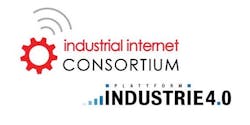Industrial Internet Consortium and Plattform Industrie 4.0 Align Architectures
While covering the rise of the Industrial Internet of Things (IIoT), I’ve spent a great deal of time following news about the Industrial Internet Consortium (IIC) and Plattform Industrie 4.0. These two organizations encapsulate and facilitate much of the work going on around the world to digitize industrial operations.
Because the IIC is focused broadly on the IIoT as it applies to numerous industries, I have heard more than a few people unjustly deride the IIC’s IIoT efforts as being “just marketing” in comparison to Industrie 4.0. People saying this often add that Industrie 4.0 is where the “real work” is happening because of Industrie 4.0’s focus on the manufacturing industries specifically.
But such disparaging comments ignore three very important things: 1) the development of a detailed IIoT reference architecture by the IIC with input from numerous industrial technology companies; 2) the importance of staying abreast of other industries’ use of similar technologies to learn valuable and often directly transferrable lessons (this is a key reason why Automation World covers industries ranging from discrete manufacturing to continuous process); and 3) the fact that IIC and Plattform Industrie 4.0 have been working together since 2015 to align their architecture efforts, understand technical issues from both perspectives and reduce market confusion.
As a key component to the third point above, the IIC and Plattform Industrie 4.0 have recently released a white paper that explains the two organizations’ ongoing efforts to align their architectures and help industry digitize its operations more effectively. To better understand this alignment, it’s important to highlight a few of the architectures’ differences and similarities.
According to the IIC, its architecture, which is named the Industrial Internet Reference Architecture (IIRA), is “an IIoT reference architecture that is business-value-driven and concern-resolution oriented. It identifies and classifies common architectural concerns into four viewpoints: business (i.e., identifying stakeholders and their business vision, value and objectives for an IIoT system), usage (how the IIoT system is expected to be used to deliver the intended business objectives), functional (the functional components and structure of an IIoT system and how they interact with each other and external elements to support the system’s intended use) and implementation (determining the technologies needed to implement functional components, their communication schemes and their lifecycle procedures). The outcomes from the analysis and resolution of concerns in these four areas are documented as models and other representations … to form the structure and the content of the architecture description.”
Plattform Industrie 4.0 says its architecture, known as the Reference Architecture Model for Industrie 4.0 (RAMI 4.0), “provides an opportunity to uncover Industrie 4.0 use cases from which standards required for those use cases can be identified. Through this process, concepts and methods in the relevant standards are reviewed to ascertain the extent to which they are suitable for applications in the Industrie 4.0 environment. The best-fitting standards are explicitly recommended to guarantee full interoperability.”
Just as the IIRA’s four viewpoints underscore its architecture, the Layers dimension of RAMI 4.0 describes six layers of properties and system structures (i.e, business, functional, information, communication, integration and asset). The RAMI 4.0 Life Cycle and Value Stream describes assets in a manufacturer’s value stream from idea and development to maintenance with respect to an asset type and the production, use and maintenance of that asset type. The Hierarchy Levels of RAMI 4.0 describe the functional hierarchy of a factory.
While the information above requires a bit of unpacking in terms of technology development and application (which you can review by accessing the whitepaper via the link above), it’s clear that despite their differences there is also a significant amount of overlap between the two approaches.
Key differences, for example, include the fact that IIRA models how an IIoT system is developed and operates primarily based on ISO/IEC/IEEE 42010, whereas RAMI 4.0 is primarily based on the Smart Grid Architecture Model.
The two architectures’ approach to communications models is also a good example of their differences. Whereas the IIRA points to DDS, OPC UA, TCP/UDP/IP, Time Sensitive Networking, web services and OneM2M as candidates for core connectivity standards, RAMI 4.0 communications layers are currently mapped to the ISO/OSI model and point to an overall preference for TCP/UDP/IP communication with OPC UA preferred for connecting production and products to the work center in ISO/OSI layers 5, 6 and 7.
With these differences in mind, both organizations acknowledge that “to enable interoperability in one or cross-industry domains, IIC and Plattform Industrie 4.0 understand the need to harmonize and improve the connectivity standard(s) including the lingua franca for IIoT.”
As for how the architectures are more alike than different, IIC and Plattform Industrie 4.0 note that “the similarities of concepts, methods and models for developing concrete architectures in IIRA and RAMI 4.0 can be mapped to each other well, despite each being based on different architecture framework standards.” The organizations point out that “much of the differences between IIRA and RAMI 4.0 lie in the different emphasis in scope and depth, and from different perspectives in examining architecture models in manufacturing where they overlap. Consequently, much of these differences are complementary and help rather than hinder addressing IIoT challenges in the digitalization of manufacturing and beyond.”
So, if you happen to find yourself in a discussion where either Plattform Industrie 4.0 or the Industrial Internet Consortium is derided as being a lesser entity, point out that these two organizations are working together closely and have been for two years now. As a result, users can expect both architectures’ ongoing development to have more in common than the original documents did when they were initially developed separately by the two organizations.
About the Author
David Greenfield, editor in chief
Editor in Chief

Leaders relevant to this article:
